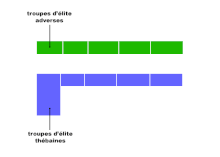The best it appears that we can come up with is to use the inbuilt skirmisher/light infantry system. This at least allows everyone in the formation to fire as fast as they can reload. It's inaccurate even as a skirmishing system, but it's closer to reality than the built in fire by rank, or fire by platoon system provided.
Nope! sorry it doesn't mean much to me at all. The ranges of muskets in this period and the limitation on the number of men who could fire in any formation means that the disparity of numbers should have made little difference unless the Swedes had deliberately spread themselves out over the field so that every Russian was able to get a good shot.
In practice the musket had an effective range of about 150 paces, which was also the approximate frontage of a battalion of 600 men deployed in line. Therefore, two infantry lines posing each other in a musketry duel would bring approximately equal numbers of muskets to bear on each other. This trend would increase as the range shortened as the ability of officers to direct fire obliquely was limited both by the close order formation of their men and their visibility of events on their flanks. Most fire was actually directed straight downrange, even if no target was visible.
If one were to take the extreme example quoted above of 2 units opposed by 5 units, both formed in line. Then:
Assuming that the units were of a standard strength of 600 men and formed in three ranks, then the smaller force would consist of 1,200 men formed on a 400 man frontage of approximately 300 paces. The larger force would consist of 3,000 men formed in three ranks on a 1,000 man frontage of approximately 650 paces.
If the two lines opposed each other at 100 paces (which is a conservative range for this period), and the units in the smaller force positioned themselves neatly opposite the centre of the large forces line, then range alone would limit the number of extra muskets it could bring to bear to about three units. e.g. half of the two flanking battalions would be able to angle their fire and bring shot to bear on the smaller force.
To achieve any more advantage the flanking battalions of the larger force would need to advance left and right shoulder forward to position themselves across the flanks of the smaller line. However the extent to which this would provide a firepower advantage would only extend to the flanks of the smaller line. The longer the smaller line is the less advantage would be gained. Thus, a Swedish line of say 11,000 infantry ranged three deep, opposed by a Russian line formed of 24,000 infantry would not suffer a firepower disadvantage of 2:1, but would only suffer a disadvantage on each of its flanks of about 1,200 muskets. The vast majority of the larger force would be unable to bring their muskets to bear, and would either have to form a second line behind those engaged or form on the flanks facing open fields.
The only thing I can think of which the Swedes could have done to make their situation worse, and allow the Russians to bring more firepower to bear, is if they followed the Go-Pa drill to the letter and tried to advance in open order. That would have effectively doubled the frontage of their units from 150 paces to 300 paces and widened their entire line so that twice as many Russian muskets could be brought to bear on them as they advanced. Though strictly speaking they should have done that in a four deep formation so even that would not have been quite so bad. It would have given then an effective frontage of 150 men per battalion deployed on a 200 man frontage.
Actually the Battle of Fraustadt which you cite as an example of the Swedish army defeating a numerically superior force highlights the point I'm making nicely as you can see how the Russo/Saxon Army was unable to exploit it's superior numbers. In this instance their situation was made worse by the fact that they were lining a defensive position and thus even their flanking units were unable to advance to bring their fire to bear.
you just change the "Can_Skirmish" ability in units_stats_lands_tables from "False" to "True". this doesnt gives the units the ability to skirmish(this happens in unit_to_ability_tables or something like this)! they just start to fire through every gap they can find in their own ranks. this allows the first 2-3 lines to fire at will. even in the tightest formation. its perfectly for mid and late 19th century warfare like US-civil war, seven weeks war, franco-prussian war, russo-turkish war,..."




 Reply With Quote
Reply With Quote










